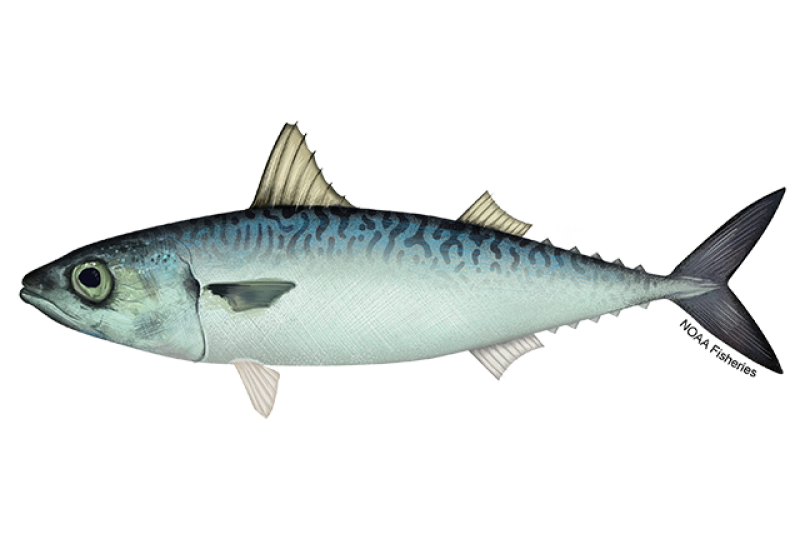Atlantic Chub Mackerel
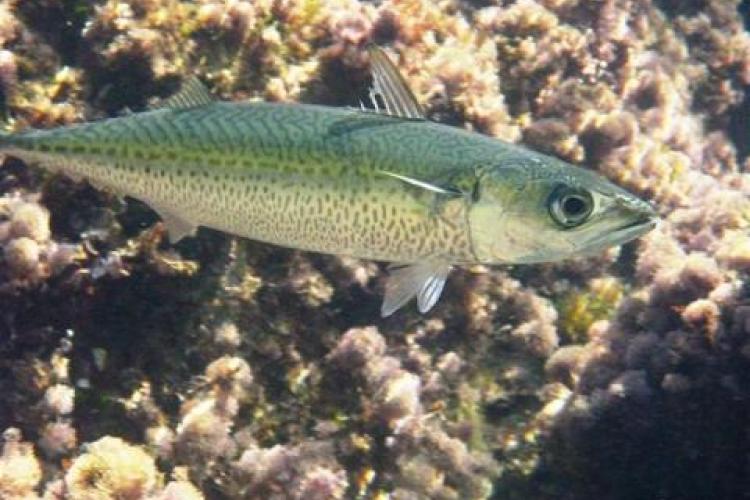 Atlantic chub mackerel. Credit: Alessandro Duci
Atlantic chub mackerel. Credit: Alessandro Duci
Atlantic chub mackerel. Credit: Alessandro Duci
About the Species
 Atlantic chub mackerel. Credit: Alessandro Duci
Atlantic chub mackerel. Credit: Alessandro Duci
Atlantic chub mackerel. Credit: Alessandro Duci
Atlantic chub mackerel are a schooling pelagic species that are found on the continental shelf to depths of about 250 to 300 meters throughout much of the western and eastern Atlantic Ocean. In the western Atlantic, their range spans from Nova Scotia (where they are rare) through Argentina, including the Gulf of America (formerly Gulf of Mexico).
Migratory patterns in the western North Atlantic are also not well understood. In the northern hemisphere, chub mackerel migrate between northern areas in warmer months and southern areas in cooler months. Adults prefer temperatures of 60 to 70°F. Some studies suggest that juveniles tend to be found closer inshore than adults.
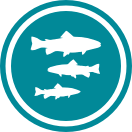
Population
The stock is not overfished.

Fishing Rate
Not subject to overfishing.

Habitat Impact
Area closures and gear restrictions protect habitat that are affected by some types of trawl gear.

Bycatch
Regulations are in place to minimize bycatch.
Population Status
Atlantic chub mackerel has never been assesssed, but is not overfished and not subject to overfishing based on 2022 catch data.
Appearance
- Atlantic chub mackerel are elongated and streamlined with deeply forked tails.
- They have small spines on the dorsal fin.
- They are silvery in color, with greenish-blue backs. The upper surfaces have dark zigzagging stripes, and the bellies are pale and marked with wavy lines.
Biology
- Atlantic chub mackerel grow up to 22 inches long and 3.5 pounds.
- They have a life span of up to about 7 years.
- They mainly feed on small crustaceans called copepods and tiny aquatic animals known as wheel animals or rotifers.
Where They Live
Range
- Atlantic chub mackerel in the western Atlantic Ocean range from Nova Scotia (where they are rare) through Argentina, including the Gulf of America.
- They are a schooling pelagic species that are found on the continental shelf to depths of about 250–300 meters throughout much of the western and eastern Atlantic Ocean.
Habitat
- Atlantic chub mackerel are a schooling pelagic species.
- They are found on the continental shelf to depths of about 250–300 meters throughout much of the western and eastern Atlantic Ocean. They can be found throughout U.S. Atlantic waters.
- Most Atlantic chub mackerel catches in offshore surveys occur south of the Hudson Shelf Valley in warm waters.
- State trawl surveys and recreational catch data suggest that Atlantic chub mackerel are also found in inshore waters.
Fishery Management
- NOAA Fisheries and the Mid-Atlantic Fishery Management Council manage the Atlantic chub mackerel fishery.
- Managed under the Mackerel, Squid, Butterfish Fishery Management Plan:
- Atlantic chub mackerel was added to the Mackerel, Squid, and Butterfish Fishery Management Plan in 2020.
- Atlantic chub mackerel was added to the FMP after a directed commercial fishery developed in federal waters. Due to that, and other considerations, the Council concluded that this species is in need of specific conservation and management measures of its own.
- Atlantic chub mackerel are managed in federal waters. There are no state management measures for mackerel.
- Managed using annual catch limits allocated between the commercial and recreational fisheries.
- Managers monitor commercial catch on a weekly basis and will close the fisheries if the limits are reached before the fishing season is over.
- Fishermen must have a Mackerel, Squid, and Butterfish permit to harvest Atlantic chub mackerel.
Harvest
- Commercial Fishery
- In 2023, commercial landings of Atlantic chub mackerel totaled 60,000 pounds and were valued at $18,000, according to the NOAA Fisheries commercial fishing landings database.
- Most commercial vessels fishing for Atlantic chub mackerel are participants in the shortfin squid fishery.
- Bottom trawl gear is used to catch Atlantic chub mackerel.
- Gear types, habitat impacts, and bycatch:
- Many habitat areas in the Atlantic chub mackerel fishery have been impacted by fishing activities over many years.
- There are gear restricted areas in place for shortfin squid vessels, designed to protect essential fish habitat.
- There are mesh size and other restrictions for shortfin squid vessels but no specific gear restrictions for Atlantic chub mackerel.
- Recreational fishery:
- Recreational catch is monitored and included in annual catch levels.
- Commercial vessels must possess a charter party permit in order to possess Atlantic chub mackerel.
- There are no size or gear limits for the recreational fleet.
Last updated by NOAA Fisheries on 04/02/2025
- Atlantic chub mackerel in the western Atlantic Ocean range from Nova Scotia (where they are rare) through Argentina, including the Gulf of America.
- They are a schooling pelagic species that are found on the continental shelf to depths of about 250–300 meters throughout much of the western and eastern Atlantic Ocean.
- Atlantic chub mackerel are a schooling pelagic species.
- They are found on the continental shelf to depths of about 250–300 meters throughout much of the western and eastern Atlantic Ocean. They can be found throughout U.S. Atlantic waters.
- Most Atlantic chub mackerel catches in offshore surveys occur south of the Hudson Shelf Valley in warm waters.
- State trawl surveys and recreational catch data suggest that Atlantic chub mackerel are also found in inshore waters.
Fishery Management
- NOAA Fisheries and the Mid-Atlantic Fishery Management Council manage the Atlantic chub mackerel fishery.
- Managed under the Mackerel, Squid, Butterfish Fishery Management Plan:
- Atlantic chub mackerel was added to the Mackerel, Squid, and Butterfish Fishery Management Plan in 2020.
- Atlantic chub mackerel was added to the FMP after a directed commercial fishery developed in federal waters. Due to that, and other considerations, the Council concluded that this species is in need of specific conservation and management measures of its own.
- Atlantic chub mackerel are managed in federal waters. There are no state management measures for mackerel.
- Managed using annual catch limits allocated between the commercial and recreational fisheries.
- Managers monitor commercial catch on a weekly basis and will close the fisheries if the limits are reached before the fishing season is over.
- Fishermen must have a Mackerel, Squid, and Butterfish permit to harvest Atlantic chub mackerel.
Harvest
- Commercial Fishery
- In 2023, commercial landings of Atlantic chub mackerel totaled 60,000 pounds and were valued at $18,000, according to the NOAA Fisheries commercial fishing landings database.
- Most commercial vessels fishing for Atlantic chub mackerel are participants in the shortfin squid fishery.
- Bottom trawl gear is used to catch Atlantic chub mackerel.
- Gear types, habitat impacts, and bycatch:
- Many habitat areas in the Atlantic chub mackerel fishery have been impacted by fishing activities over many years.
- There are gear restricted areas in place for shortfin squid vessels, designed to protect essential fish habitat.
- There are mesh size and other restrictions for shortfin squid vessels but no specific gear restrictions for Atlantic chub mackerel.
- Recreational fishery:
- Recreational catch is monitored and included in annual catch levels.
- Commercial vessels must possess a charter party permit in order to possess Atlantic chub mackerel.
- There are no size or gear limits for the recreational fleet.
Last updated by NOAA Fisheries on 04/02/2025
Recreational Fishing Regulations
There is no recreational possession limit for chub mackerel. If you are on a trip carrying paying customers and you possess chub mackerel in federal waters, you must hold a Squid, Mackerel, and Butterfish Category 2 Charter/Party Permit.

Reporting A Recreational Catch
Charter/Party and Recreational Reporting
Catch Reporting and Vessel Trip Reports
If the owner of a party or charter boat is issued only a charter/party permit, and is carrying passengers for hire, then they must complete a VTR for each trip on which they land any fish.
Interactive Voice Response System Requirements
The Atlantic mackerel, squid, and butterfish fisheries do not have any IVR requirements. However, if you are participating in a research program such as research set-aside (RSA) or fishing with an exempted fishing permit (EFP), there are IVR requirements. Please refer to your RSA or EFP paperwork for instruction on using IVR.
Marine Recreational Information Program
The Marine Recreational Information Program (MRIP) is a system of coordinated voluntary data collection programs designed to estimate recreational catch and effort.
Last updated by NOAA Fisheries on 04/02/2025
Commercial Fishing Regulations
Current Specifications
Fishery specifications apply to Atlantic chub mackerel caught by vessels fishing in the Atlantic Chub Mackerel Management Unit (federal waters from Maine through North Carolina). Specifications can be set up for three years at a time and are reviewed annually and adjusted as new information becomes available.
2024 and Projected 2025 Chub Mackerel Specifications in Metric Tons (mt)
Specification | 2024 | 2025 (Projected) |
Acceptable biological catch (ABC) | 2,300 | 2,300 |
Annual catch limit (ACL) | 2,262 | 2,262 |
Annual catch target (ACT) | 2,171 | 2,171 |
Total allowable landings (TAL) | 2,041 | 2,041 |
All Atlantic chub mackerel catch counts against one annual catch limit; there is no separation of catch limits between the commercial and recreational fisheries.

Possession Limits and Accountability Measures
Initially, possession of chub mackerel is unlimited. To prevent the ACT from being exceeded, NOAA Fisheries will implement a 40,000-lb possession limit when 90 percent of the TAL is landed, and a 10,000-lb possession limit once 100 percent of the TAL is landed.
| Possession Limit | Pounds |
| Initial | Unlimited |
| When 90 Percent of TAL Is Landed | 40,000 |
| When 100 Percent of TAL Is Landed | 10,000 |
If the ACL is exceeded based on total commercial and recreational catch within the Management Unit, we will reduce the ACT by the amount of the overage as soon as possible in a future fishing year.
Transit Measure
A vessel issued a federal commercial fishing permit from Greater Atlantic Regional Fisheries Office that possesses Atlantic chub mackerel in excess of the allowed possession limits may transit the Management Unit if:
- Atlantic chub mackerel was caught outside of the Management Unit; and
- All gear is stowed and not available for immediate use.
Reporting A Commercial Catch
Vessels and dealers must be issued a federal permit for any species managed by the FMP (Atlantic mackerel, Illex squid, longfin squid, or butterfish) to fish for, possess, land, sell, or purchase Atlantic chub mackerel caught in the Management Unit. An operator of a commercial vessel must also obtain and retain on board a valid operator permit issued by the Greater Atlantic Regional Fisheries Office.
Vessel operators must report the catch of Atlantic chub mackerel weekly on existing vessel trip reports (logbooks). This action does not change existing vessel monitoring system (VMS) declaration or daily reporting requirements. Vessel operators must continue to declare squid and mackerel trips via VMS and submit daily VMS catch reports when fishing for Atlantic mackerel, Illex squid, or longfin squid. Dealers purchasing Atlantic chub mackerel must report such purchases via existing weekly dealer reports.
Commercial Gear Information
There are gear-restricted areas in place for Illex squid vessels, which primarily participate in the chub mackerel fishery. These restrictions protect essential fish habitat. There are also mesh size restrictions for Illex squid vessels. There are no specific gear restrictions for chub mackerel as the primary participants in the EEZ are participating in the Illex squid fishery, which has established restrictions. For more information about gear-restricted areas, please see the chub mackerel regulated, closed, and access areas webpage.
Last updated by NOAA Fisheries on 04/02/2025
Seafood Facts
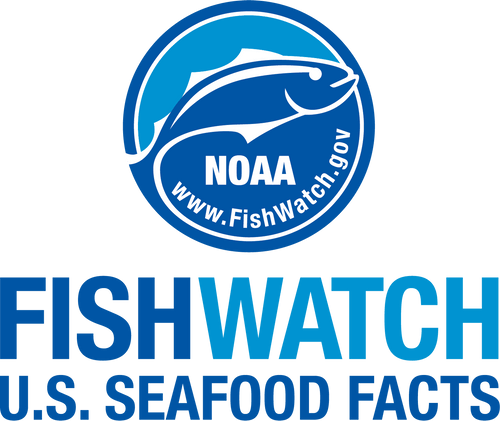
Is Atlantic Chub Mackerel Sustainable?
U.S. wild-caught Atlantic chub mackerel is a smart seafood choice because it is sustainably managed and responsibly harvested under U.S. regulations.
Availability
Year-round.
Source
U.S. wild caught from Southern New England to the Gulf of America (formerly Gulf of Mexico).
Taste
Rich, pronounced flavor.
Texture
Soft, flaky, and moist.
Health Benefits
Chub mackerel is high in omega-3 fatty acids.
Nutrition Facts
Servings: 1; Serving Weight: 100 g (raw); Calories: 205; Protein: 18.6 g; Total Fat: 13.89 g; Total Saturated Fatty Acids: 3.257 g; Carbohydrate: 0 g; Total Sugars: 0 g; Total Dietary Fiber: 0 g; Cholesterol: 70 mg; Selenium: 44.1 mcg; Sodium: 90 mgMore Information
Mackerel Recipes
Need some cooking inspiration to incorporate mackerel into your rotation? Browse these recipes for grilled herb-broiled mackerel, pasta with mackerel, and more!

Last updated by NOAA Fisheries on 04/02/2025
Seafood News
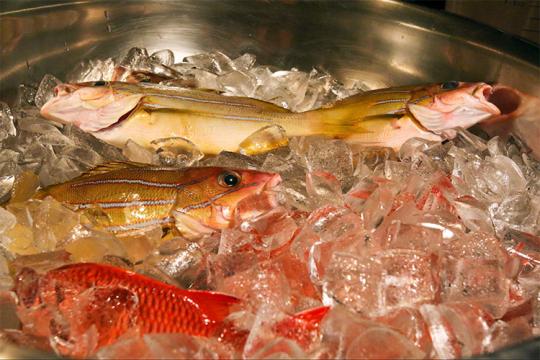 Fresh-caught taʻape on ice. Credit: Conservation International Hawaiʻi.
Fresh-caught taʻape on ice. Credit: Conservation International Hawaiʻi.
Reducing Waste and Feeding Communities in Hawaiʻi with a Whole Fish Approach
 Chef Tyler Hadfield’s Curried Skate Wings with Tomato-Masala Chutney
Chef Tyler Hadfield’s Curried Skate Wings with Tomato-Masala Chutney
Ring In the New Year With These Crowd-Favorite Seafood Recipes
 NOAA Fisheries, in collaboration with Blue Ocean Mariculture, is conducting a multi-year pilot study to evaluate observational methods and tools for studying Hawaiian monk seal behavior. Courtesy of Blue Ocean Mariculture
NOAA Fisheries, in collaboration with Blue Ocean Mariculture, is conducting a multi-year pilot study to evaluate observational methods and tools for studying Hawaiian monk seal behavior. Courtesy of Blue Ocean Mariculture
AI Meets Aquaculture to Study Hawaiian Monk Seal Interactions With Net Pens
 Tonya Wick aboard a fishing vessel at sea in 1998. Photo courtesy of Tonya Wick
Tonya Wick aboard a fishing vessel at sea in 1998. Photo courtesy of Tonya Wick
Regulated, Closed, and Access Areas
Atlantic Chub Mackerel Management Unit
The Atlantic Chub Mackerel Management Unit includes federal waters from Maine through North Carolina.

Atlantic Mackerel, Squid, and Butterfish Fishery Restricted Areas
| Oceanographer Canyon | Lydonia Canyon | Northern Scup Gear Restricted Area (GRA) | Southern Scup GRA |
| January 1–December 31 | January 1–December 31 | November 1–December 31 | January 1–March 15 |
| Bottom trawl gear prohibited | Bottom trawl gear prohibited | Minimum mesh size of 5.0 inch diamond mesh | Minimum mesh size of 5.0 inch diamond mesh |
| Transit allowed if bottom trawl gear is stowed and not available for immediate use. | Transit allowed if bottom trawl gear is stowed and not available for immediate use. | Transit allowed if codends less than 5.0 inches are stowed and not available for immediate use. | Transit allowed if codends less than 5.0 inches are stowed and not available for immediate use. |
| Applies to all permitted mackerel, squid, or butterfish vessels | Applies to all permitted mackerel, squid, or butterfish vessels | Applies to all trawl vessels fishing for longfin squid, black sea bass, or silver hake (whiting) | Applies to all trawl vessels fishing for longfin squid, black sea bass, or silver hake (whiting) |
*Coordinates for each area are listed below.
Oceanographer and Lydonia Canyons
| Oceanographer Canyon Coordinates | Lydonia Canyon Coordinates | |||
| N. Lat. | W. Long. | N. Lat. | W. Long. | |
| 40°10.0' | 68°12.0' | 40°16.0' | 67°34.0' | |
| 40°24.0' | 68°09.0' | 40°16.0' | 67°42.0' | |
| 40°24.0' | 68°08.0' | 40°20.0' | 67°43.0' | |
| 40°10.0' | 67°59.0' | 40°27.0' | 67°40.0' | |
| 40°10.0' | 68°12.0' | 40°27.0' | 67°38.0' | |
| 40°16.0' | 67°34.0' | |||
Scup GRAs
| Southern GRA Coordinates | Northern GRA Coordinates | |||
| N. Lat. | W. Long. | N. Lat. | W. Long. | |
| 39°20' | 72°53' | 41°00' | 71°00' | |
| 39°20' | 72°28' | 41°00' | 71°30' | |
| 38°00' | 73°58' | 40°00' | 72°40' | |
| 37°00' | 74°43' | 40°00' | 72°05' | |
| 36°30' | 74°43' | 41°00' | 71°00' | |
| 36°30' | 75°03' | |||
| 37°00' | 75°03' | |||
| 38°00' | 74°23' | |||
| 39°20' | 72°53' | |||
Last updated by NOAA Fisheries on 04/02/2025
Management Overview

How is the fishery managed?
Mackerel, squid, and butterfish are jointly managed in federal waters by NOAA Fisheries and the Mid-Atlantic Fishery Management Council. The chub mackerel fishery is managed through the use of annual quotas, accountability measures, and possession limits.
What is the fishing year for this fishery?
January 1–December 31.
What are the different management areas for this fishery?
The Atlantic Chub Mackerel Management Unit includes federal waters from Maine through North Carolina.
Management Plans
Mackerel, squid, and butterfish are managed in federal waters under the Mackerel, Squid and Butterfish Fishery Management Plan (FMP). Chub mackerel was not initially included as a managed species under this FMP. However, concerns about the species' potential role as prey in the ecosystem, coupled with the emergence of a targeted commercial fishery during 2013-2015, led to the adoption of placeholder regulations for chub mackerel in 2017 (Amendment 18). Chub mackerel was formally added to the Mackerel, Squid, and Butterfish FMP in 2021 (Amendment 21).

Regulatory History
Management Timeline
1978: Atlantic Mackerel FMP established management of Atlantic mackerel fishery
1978: Atlantic Butterfish FMP established management of Atlantic butterfish fishery
1978: Squid FMP established management of squid fisheries
1979: Atlantic Mackerel Amendment 1 continued management of the Atlantic mackerel fishery
1979: Squid Amendment 1 continued management of the squid fishery
1980: Atlantic Butterfish Amendment 1 continued management of the Atlantic butterfish fishery
1980: Atlantic Mackerel Amendment 2 continued management of the Atlantic mackerel fishery.
1980: Atlantic Butterfish Amendment 2 continued management of the Atlantic butterfish fishery.
1983: Merged FMP consolidated management of Atlantic mackerel, squid, and butterfish fisheries under a single FMP.
1984: Amendment 1 implemented squid OY adjustment mechanism and revised the Atlantic mackerel mortality rate.
1986: Amendment 2 revised squid bycatch TALFF allowances, implemented framework adjustment process, converted expiration of fishing permits from indefinite to annual, and equated fishing year with calendar year.
1991: Amendment 3 established overfishing definitions for all four species.
1991: Amendment 4 limited the activity of directed foreign fishing and joint venture transfers to foreign vessels and allowed for specification of OY for Atlantic mackerel for up to three years.
1996: Amendment 5 adjusted Loligo MSY; eliminated directed foreign fisheries for Loligo, Illex, and butterfish; instituted a dealer and vessel reporting system; instituted an operator permitting system; implemented a limited access system for Loligo, Illex and butterfish; and expanded the management unit to include all Atlantic mackerel, Loligo, Illex, and butterfish under U.S. jurisdiction.
1997: Amendment 6 revised the overfishing definitions for Loligo, Illex, and butterfish; established directed fishery closure at 95 percent of DAH for Loligo, Illex and butterfish with post-closure trip limits for each species; and established a mechanism for seasonal management of the Illex fishery to improve the yield-per recruit.
1997: Amendment 7 established consistency among FMPs in the NE region of the U.S. relative to vessel permitting, replacement and upgrade criteria.
1998: Amendment 8 brought the FMP into compliance with new and revised National Standards and other required provisions of the Sustainable Fisheries Act. This action also added a framework adjustment procedure.
2001: Framework 1 created a quota set-aside for the purpose of conducting scientific research
2002: Framework 2 extended the moratorium on entry to the Illex fishery for an additional year; established that previous year specifications apply when specifications for the management unit are not published prior to the start of the fishing year (excluding TALFF specifications); and allowed for the specification of management measures for Loligo for a period of up to three years.
2003: Framework 3 extended the moratorium on entry to the Illex fishery for an additional year.
2004: Framework 4 extended the moratorium on entry to the Illex fishery for an additional five years
2007: Amendment 12 implemented standardized bycatch reporting methodology.
2008: Amendment 9 allowed for multi-year specifications for all four managed species (mackerel, butterfish, Illex, and Loligo) for up to 3 years; extended the moratorium on entry into the Illex fishery, without a sunset provision; adopted biological reference points for Loligo recommended by the stock assessment review committee (SARC); designated EFH for Loligo eggs based on available information; and prohibited bottom trawling by MSB-permitted vessels in Lydonia and Oceanographer Canyons.
2010: Amendment 10 implemented a butterfish rebuilding program, increased the Loligo minimum mesh in Trimesters 1 and 3, and implemented a 72-hour trip notification requirement for the Loligo fishery.
2010: Amendment 13 implemented Annual Catch Limits (ACLs), Annual Catch Targets (ACTs), and Accountability Measures (AMs).
2011: Amendment 11 implemented Limited Access in the Atl. mackerel fishery, updated EFH for all mackerel, squid, butterfish species, and established a recreational-commercial allocation.
2012: Framework 5 broadened the scope of individuals who can perform hold measurements for limited access mackerel vessels
2012: Framework 6 clarified the Council's risk policy and describes the limited circumstances under which acceptable biological catch (ABC) can be increased for stocks without status determination criteria on overfishing.
2013: Framework 7 converted the butterfish mortality cap from a catch cap to a discard cap
2014: Amendment 14 implemented a variety of reporting and monitoring requirements for Atlantic mackerel and longfin squid fisheries, and implemented a river herring and shad catch cap for the Atlantic mackerel fishery (Appendices).
2013: Amendment 17 modified accountability measures for the Council's recreational fisheries, including Atlantic mackerel.
2014: Framework 8 implemented changes to improve operation of the butterfish discard cap in the longfin squid fishery and the directed butterfish fishery.
2015: Amendment 15 implemented Standardized Bycatch Reporting Methodology.
2015: Amendment 19 eliminated the requirement for vessel owners to submit "did not fish" reports for the months or weeks when their vessel was not fishing. This action also removed some of the restrictions for upgrading vessels listed on federal fishing permits.
2015: Framework 9 established measures to enhance catch monitoring and address slippage (catch that is discarded before it has been sampled by observers) in the Atlantic mackerel fishery.
2016: Amendment 16 - Deep Sea Corals Amendment established management measures to protect deep sea corals from the impacts of commercial fishing gear in the Mid-Atlantic region.
2017: Amendment 18 - Unmanaged Forage Omnibus Amendment implemented management measures to prevent the development of new, and the expansion of existing, commercial fisheries on certain forage species in the Mid-Atlantic.
2017: Framework 10 - Omnibus For-Hire Electronic Trip Reporting Framework implemented a requirement for vessels that hold party/charter permits for Council-managed species to submit vessel trip reports electronically (eVTRs) while on a trip carrying passengers for hire.
2018: Framework 11 - Omnibus Acceptable Biological Catch Framework established a process for setting constant multi-year Acceptable Biological Catch (ABCs) limits for Council-managed fisheries; clarified that the Atlantic Bluefish, Tilefish, and Atlantic Mackerel, Squid, and Butterfish FMPs will now automatically incorporate the best available scientific information in calculating ABCs (as all other Mid-Atlantic management plans do) rather than requiring a separate management action to adopt them; clarified the process for setting ABCs for each of the four types of ABC control rules.
2018: Amendment 20 - Squid Amendment reduced latent directed permits, created limited access incidental permits, and lowered Trimester 2 post-closure trip limit to 250 pounds to discourage directed fishing after closures. Final Rule.
2018: Framework 12 - Atlantic Mackerel Closure Provisions Framework allowed the possession of 5,000 lb of Atlantic mackerel after 100 percent of the domestic annual harvest is caught instead of prohibiting the possession of Atlantic mackerel for the rest of the year.
2019: Framework 13 - Atlantic Mackerel Rebuilding Framework with Specifications established a 5-year rebuilding program for Atlantic mackerel, set 2019-2021 Atlantic mackerel specifications and a river herring and shad cap for the Atlantic mackerel fishery, modified the Council's risk policy, and modified in-season closure measures.
2020: Amendment 21 - Chub Mackerel Amendment established management of Atlantic chub mackerel fishery through the Mackerel, Squid, and Butterfish Fishery Management Plan
2020: Framework 14 - Omnibus Commercial Electronic Reporting Framework established a requirement for commercial vessels with federal permits for all species managed by the Mid-Atlantic and New England Councils to submit vessel trip reports electronically within 48 hours after entering port at the conclusion of a trip.
2020: Framework 15 - Omnibus Acceptable Biological Catch and Risk Policy Framework modified the Council’s ABC control rule and risk policy. The revised risk policy is intended to reduce the probability of overfishing as stock size falls below the target biomass while allowing for increased risk and greater economic benefit under higher stock biomass conditions. This action also removed the typical/atypical species distinction currently included in the risk policy.
2023: Amendment 23 - Atlantic Mackerel Rebuilding 2.0 Amendment established a revised Atlantic mackerel rebuilding plan, set the 2023 Atlantic mackerel specifications and a river herring and shad catch cap for the Atlantic mackerel fishery, established a recreational possession limit, and modified in-season closure measures.
2024: Framework 16 - Illex Hold Framework established a hold capacity baseline requirement for limited access Illex squid vessels, allowed NOAA Fisheries to collect processing type information from limited access Illex and Tier 1 longfin squid vessels, and clarified existing VMS requirements.
Under Development
None at this time.
More Information
Last updated by NOAA Fisheries on 04/02/2025
Science Overview
NOAA Fisheries conducts various research activities on the biology, behavior, and population health of chub mackerel. The results of this research are used to inform management decisions for this species.
For detailed information about stock status, management, assessments, and resource trends, you can search for chub mackerel, or any other species of interest, using NOAA’s StockSMART web tool.
Stock Assessment Review Index
Fishery Stock Assessments in New England and the Mid-Atlantic provides general information about stock assessments, and the Stock Assessment Review Index contains copies of completed assessment documents.
More Information
Last updated by NOAA Fisheries on 04/02/2025



